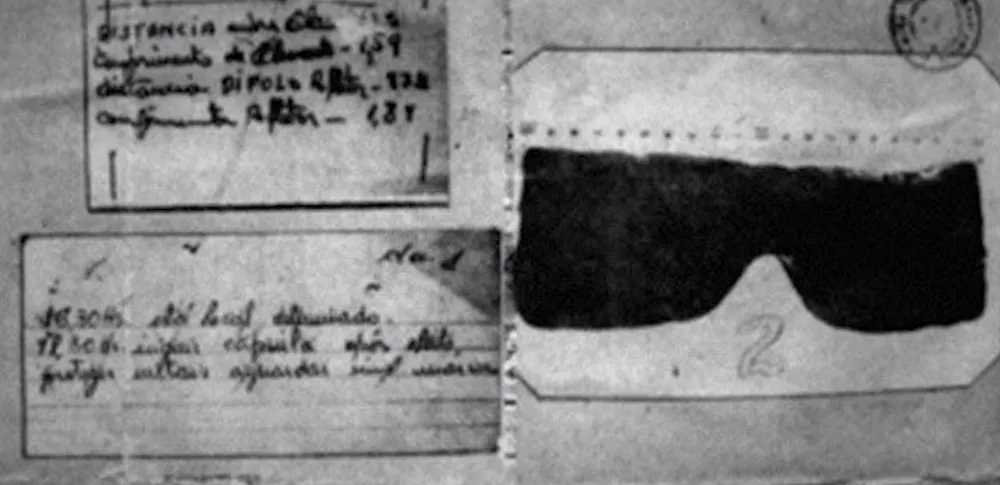
On a quiet August afternoon in 1966, a young boy flying a kite on Morro do Vintém—a scrub-covered hill just outside Rio de Janeiro—saw something strange in the weeds.
Two bodies. Side by side. Perfectly still.
He ran home, terrified. When the police arrived later, what they found wasn’t just a pair of corpses. It was a riddle that would confound Brazil’s investigators, fuel decades of conspiracy theories, and leave behind one of the most chilling unsolved cases in the country’s history.
Both men were dressed in formal suits, covered in waterproof raincoats. On their faces: thick, homemade lead masks shaped like sunglasses with no arms—just curved slabs of metal shielding their eyes.
There were no wounds. No signs of struggle. No obvious cause of death.
Next to the bodies lay a water bottle, two towels, and a small notebook. Inside the notebook, a note scribbled in shaky handwriting read:
“Be at the specified location at 16:30. Take capsules after the effect, protect metals, await signal mask.”
It made no sense. And that was just the beginning.

The Men in the Suits
The two men were identified as Manoel Pereira da Cruz and Miguel José Viana. They were both in their thirties, both television repairmen, and both from Campos dos Goytacazes, a small town a few hours from Rio.
By all accounts, they were responsible, well-liked, and not the kind of men you’d expect to find dead on a remote hillside.
On August 17, they told their families they were headed to São Paulo to buy electronics for work. They packed a small bag, withdrew a sizable amount of cash, and boarded a bus to Niterói instead.
On the way, they stopped to buy waterproof coats. They also picked up a bottle of water from a bar. The waitress remembered Miguel as nervous, checking his watch repeatedly.
They asked for the receipt—odd behavior, since the bottle was cheap. But the receipt was timestamped. They were building a timeline.
By 2:30 p.m. that day, they were seen hiking up Morro do Vintém.
That was the last time anyone saw them alive.

The Scene on the Hill
What baffled investigators wasn’t just how the men died, but why they were there at all.
They didn’t bring food. They had no camping supplies. The towels seemed randomly placed. And those lead masks? Thick, clumsy, and clearly handmade.
They looked like they were preparing for something—something dangerous.
Some speculated they were protecting themselves from radiation. Others suggested the masks were used in spiritual rituals to shield the eyes from bright lights.
But if they were expecting a bright light… what kind?
And who told them to expect it?

No Cause of Death
The autopsy didn’t help.
Brazil’s forensic labs at the time were overwhelmed. By the time coroners could examine the bodies, internal organs had decomposed beyond analysis. Toxicology was impossible.
No drugs were ever confirmed. No poisons detected. No trauma found.
The men were simply dead.
But the note—that strange, ritualistic note—suggested they had taken capsules willingly. Whatever the capsules were, they were clearly meant to trigger an “effect.” After that, they were to “protect metals” and “await signal.”
What kind of signal? And from whom?
Theories Begin to Spiral
Once word of the case spread, it exploded into the tabloids. The public was fascinated. And terrified.
Rumors swirled that the men were part of a secret society. That they were attempting psychic communication. That they believed they could contact extraterrestrial beings.
It wasn’t all just speculation. Miguel and Manoel had a reputation in their town for dabbling in scientific spiritualism—a Brazilian blend of mysticism, Spiritism, and amateur electronics.
According to friends, they were obsessed with building devices to communicate with the spirit world. Some believed they were experimenting with hallucinogens to reach altered states of consciousness.
In fact, police found notebooks back home filled with diagrams, instructions, and coded plans—many eerily similar to the note found in Miguel’s pocket.
One entry read:
“After ingesting the capsule, wait for the protective effect. Signal to be received in luminous form.”
It wasn’t the first time they’d tried something like this.
But this time, it would be their last.
Back to the Scene
Despite the growing media frenzy, police kept circling the same problem: nothing physical pointed to foul play.
No one had seen them with anyone else. There were no marks on their bodies. No obvious signs of overdose.
Still, some investigators weren’t satisfied.
How did two men die at the same time, in the same position, without a single struggle? And why go through all the trouble of hiking to that hill, carrying towels and lead masks?
Why wear suits?
If it was suicide or a ritual experiment gone wrong, where were the drugs? Where were the vomiting, the seizures, the foam? The bodies looked peaceful, not distressed.
One investigator remarked:
“They laid themselves down like they were waiting for something. But no one knows what.”
The Signal That Never Came
Some locals believed the men had been lured into a cult or a deadly hoax. Others insisted it was a UFO contact gone wrong.
The hill, after all, had long been rumored to be a hotspot for strange lights. Multiple witnesses claimed to have seen glowing orbs in the area in the days before and after the deaths.
And in Brazil’s 1960s, UFO sightings were often treated as serious phenomena.
But nothing ever came of those leads. The only thing clear was this: Miguel and Manoel believed something was going to happen. Some signal. Some revelation. Maybe even transcendence.
Instead, they died alone under gray skies, waiting.
The Man Who Wasn’t There
When investigators looked closer at Miguel and Manoel’s final days, a new presence began to emerge. Someone whose name never made the headlines. Someone who may have held the real key to everything that happened on Morro do Vintém.
A third man.
He was never identified, never found, and—according to some reports—never officially acknowledged. But multiple witnesses said the two victims weren’t alone on their journey.
And that’s where the case truly starts to unravel.
The Mysterious Third Companion
At the bus depot in Campos, witnesses saw Miguel and Manoel buying tickets—alongside another man. He was described as taller, older, more confident. But when the bodies were found, he was nowhere to be seen.
Who was he?
Was he a friend? A guide? A spiritual mentor?
Or was he the one who handed them the capsules and walked away?
Police tried to trace him, but nothing solid came back. No name. No photo. No leads.
Some suspected he was a member of a secretive spiritualist circle in Campos. Others believed he was a charlatan—someone who had convinced the men they could reach higher planes, make contact with alien entities, or transcend physical existence.
Whatever his role, he vanished without a trace. And the silence left behind was deafening.
A Town That Dabbled in the Unknown
Campos dos Goytacazes wasn’t just a sleepy town with two curious technicians. In the 1960s, Brazil was steeped in a mix of Catholicism, Kardecist Spiritism, mysticism, and a growing fascination with flying saucers.
Spiritism—especially the version practiced in Brazil—encouraged communication with the dead, astral projection, and other metaphysical pursuits. Many believed technology could enhance these abilities.
Miguel and Manoel weren’t outsiders to this world. They were deeply involved.
One former associate told police the two men had previously attempted a similar ritual using capsules. That attempt ended in panic. One of them allegedly collapsed and had to be revived. The ritual was considered a failure.
But instead of stopping, they doubled down.
They became convinced that the “failures” were due to interference—electromagnetic or spiritual. They began crafting devices. One neighbor described them building circuits late into the night, sketching antennae, and writing coded formulas in notebooks.
They believed that with the right mix of chemicals, shielding, and faith, they could receive messages—possibly even visions—from other realms.
The Lead Masks Revisited
So why the lead masks?
Some theorized they were based on spiritual texts claiming that “pure beings” emit a blinding light—too intense for human eyes. In some Spiritist circles, this was interpreted literally. If contact with a higher power occurred, one needed protection.
But others saw something else: the language of UFO contact.
In the 1950s and 60s, Brazil had an explosion of UFO reports—many centered around Rio and the surrounding regions. Witnesses described beams of light, sudden burns, strange metallic debris, and nausea after contact.
Lead, as a radiation shield, would make sense. The masks weren’t just spiritual—they were functional.
Maybe the men believed they were going to witness a ship. Maybe they thought they were being summoned.
And maybe someone told them they would be safe, as long as they followed the instructions precisely.
The Instructions That Didn’t Work
The note in Miguel’s pocket was more than just strange. It was specific. Timed. Ritualistic.
“Be at the specified location at 16:30. Take capsules after the effect, protect metals, await signal mask.”
The timing indicates a planned event. The mention of “capsules” suggests preparation. “Protect metals” remains one of the most debated lines—did they carry metallic objects? Devices? Coins? Radios?
Or was it metaphorical?
Some believe “metals” referred to their own bodies—strength, the soul, the vessel. Others think they had devices nearby, possibly dismantled or hidden.
But the most chilling line? “Await signal.”
They believed something would come.
It never did.
The Lead Masks Case Repeats Itself?
Years later, rumors began to surface about similar cases. Men found dead in remote places. Notes left behind. Unexplained phenomena. But none ever gained the same attention.
One account described another man in Campos who claimed he had been invited to a ritual with Miguel and Manoel—but backed out at the last minute. He later disappeared.
Another theory surfaced that the capsules weren’t hallucinogens or poisons, but sedatives. That the men were meant to lose consciousness and be “taken”—either spiritually or physically.
And when nothing happened, they simply never woke up.
No trauma. Just silence.
The Final Possibility: They Were Killed
For all the spiritual speculation, there remains a very human possibility: murder.
If someone wanted to kill them quietly—without leaving marks, without a scene—what better way than to let them poison themselves?
Lure them with promises of enlightenment. Make them believe they were going to witness something divine. Give them timed instructions. Let them die without resistance.
And walk away.
No struggle. No evidence. No crime.
Only belief.
Why It Still Haunts Us
The Lead Masks Case endures because it sits at the crossroads of so many human fascinations: science, mysticism, trust, secrecy, and death.
It’s a story about two men who believed so deeply in something—be it spiritual truth, alien contact, or personal transcendence—that they gave their lives to it.
And yet we don’t know what it was.
Their lead masks are now symbols. Not just of mystery, but of the blind spots in our understanding—of history, of belief, of what people will risk for meaning.
There’s No Ending. That’s the Ending.
The case was officially closed without answers. No suspects. No cause of death. No closure for the families.
But that doesn’t mean it’s over.
The notebooks still exist. The theories still circulate. And Morro do Vintém still looms over Niterói, quiet, overgrown, and watching.
Some say that if you stand there at dusk, and the wind is right, you can still hear static.
Or maybe that’s just what we want to believe.
Either way, the signal never came.
And two men died waiting.





